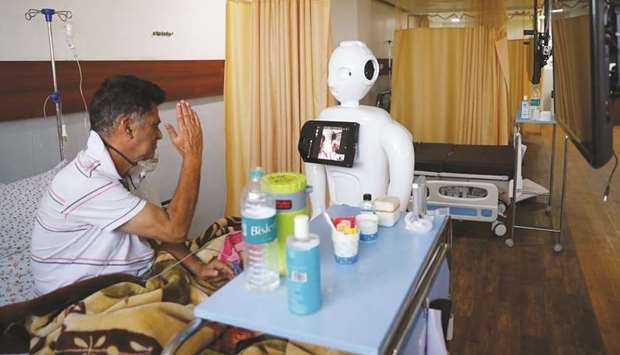A hospital in India has deployed a customer-service robot to patrol its wards, connecting coronavirus patients to friends and relatives.
Mitra, meaning “friend” in Hindi, is best known for interacting with Prime Minister Narendra Modi at an event in 2017.
Its piercing eyes are equipped with facial recognition technology to help it recall people it has previously interacted with.
A tablet attached to Mitra’s chest allows patients to see loved ones, as well as medical staff unable to access the wards.
“It takes a lot of time to recover, and during this time, when patients need their families the most, they are unable to visit,” said Dr Arun Lakhanpal, a doctor at the Yatharth Super Speciality Hospital in Noida Extension, a satellite city of the New Delhi.
Mitra is mainly used by patients who are not able to communicate using their phones.
“We mainly discuss my health,” said Makhanlal Qazi, a retired government bureaucrat and coronavirus patient who has used the robot to communicate with relatives.
“I came here on Friday and now I have started feeling better. I am feeling very happy now.”
The robot, developed by Bengaluru-based start-up Invento Robotics, cost the hospital Rs1mn ($13,600), according Yatharth Tyagi, director of the company that runs the hospital.
Mitra is also being used for remote consultations with specialists to reduce their risk of becoming infected, he added.
“Normally it is very difficult for a psychologist or a dietician to see a Covid patient,” Tyagi said, adding the robot is “very useful”.
Meanwhile, as India’s coronavirus infections surged past 5mn yesterday, hospitals are grappling with unreliable supplies of oxygen that they need to treat tens of thousands of critical patients.
In the big states of Maharashtra, Gujarat and Uttar Pradesh, that are also some of the worst-affected by the virus, demand for oxygen has more than tripled, doctors and government officials said, prompting urgent calls for help.
“Desperate patients have been calling me through the night but I don’t know when I will get stock,” Rishikhesh Patil, an oxygen supplier in Nashik, said.
At least 6% of India’s nearly 1mn active cases need oxygen support, Health Ministry official Rajesh Bhushan told reporters.
Supplies were adequate but state governments should monitor usage and flag shortages, he said.
“The problem happens when at a facility level, if there is no inventory management. Every state should ensure this,” Bhushan said.
In the capital of India’s most populous state of Uttar Pradesh, the total requirement of oxygen cylinders stood at 5,000 compared with 1,000 cylinders in normal times, a government official said.
The worst-affected state of Maharashtra has decided to reduce supply to neighbouring states to meet its growing demand, a state government official said.
Vehicles carrying oxygen will get right of way and can use sirens to ensure they reach hospitals faster.
Ravindra Khade Patil, a doctor who manages two private hospitals on the outskirts of Mumbai, spoke of the stress he faces trying to ensure he can supply his patients with oxygen.
Two days ago, the supplier of oxygen to his hospitals did not turn up at his usual time.
Patil made frantic calls to the supplier and then to nearby hospitals and lawmakers, knowing that if the oxygen didn’t arrive on time, it would be too late for some of his most critical patients.
Finally, past midnight, thanks to pressure from a government official, the oxygen tanks arrived.
“If they had arrived even a couple of hours late, we could have lost five or six patients. Every day, we are worried if we will be able to meet our requirements, if the oxygen will arrive or not,” Patil said.

A patient suffering from the coronavirus disease speaks to his family members, using ‘Mitra’ at the Intensive Care Unit of the Yatharth Super Speciality Hospital in Noida.


